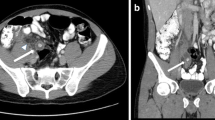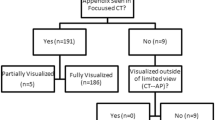Abstract
The purposes of this study were to determine the (1) frequency with which nonenhanced computed tomography (CT) (NECT) permits conclusive diagnosis of acute appendicitis, (2) accuracy of NECT when findings are conclusive, and (3) overall accuracy of a CT protocol consisting of NECT with selective use of contrast. Five hundred and thirty-six patients underwent a NECT protocol with selective use of contrast. Diagnostic accuracy was then determined separately for (1) patients with conclusive initial NECT, (2) patients with inconclusive initial NECT, and (3) all patients. NECT was conclusive on initial interpretation in 404/536 patients and inconclusive in 132/536. Of 132 inconclusive studies, 126 were repeated with contrast (intravenous, oral or rectal). Sensitivity, specificity, and positive and negative predictive value for diagnosis of acute appendicitis were (1) 90%, 96.0%, 84.8%, and 97.4% in patients with conclusive NECT (n = 404); (2) 95.6%, 92.3%, 73%, and 99% in patients with inconclusive NECT followed by repeat CT with contrast; and (3) 91.3%, 95%, 82%, and 98% in all patients. The initial diagnosis of appendicitis may be made by NECT in 75% of patients, with contrast administration reserved for inconclusive NECT studies.






Similar content being viewed by others
References
Flum DR, Koepsell T (2002) The clinical and economic correlates of misdiagnosed appendicitis: nationwide analysis. Arch Surg 137(7):799–804
Hale DA et al (1997) Appendectomy: a contemporary appraisal. Ann Surg 225(3):252–261
Flum DR et al (2001) Has misdiagnosis of appendicitis decreased over time? A population-based analysis. JAMA 286(14):1748–1753
Schmidt T et al (2005) Phase-inversion tissue harmonic imaging compared to fundamental B-mode ultrasound in the evaluation of the pathology of large and small bowel. Eur Radiol 15(9):2021–2030
Lee SY et al (2006) Prospective comparison of helical CT of the abdomen and pelvis without and with oral contrast in assessing acute abdominal pain in adult Emergency Department patients. Emerg Radiol 12(4):150–157
Tsushima Y et al (2002) Effect of contrast-enhanced computed tomography on diagnosis and management of acute abdomen in adults. Clin Radiol 57(6):507–513
Basak S et al (2002) Is unenhanced CT sufficient for evaluation of acute abdominal pain? Clin Imaging 26(6):405–417
Christopher FL et al (2002) Unenhanced helical CT scanning of the abdomen and pelvis changes disposition of patients presenting to the emergency department with possible acute appendicitis. J Emerg Med 23(1):1–7
Tamburrini S et al (2005) CT appearance of the normal appendix in adults. Eur Radiol 15(10):2096–2103
Funaki B (2000) Nonenhanced CT for suspected appendicitis. Radiology 216(3):916–918
Ege G et al (2002) Diagnostic value of unenhanced helical CT in adult patients with suspected acute appendicitis. Br J Radiol 75(897):721–725
Lowe LH et al (2000) Appendicolith revealed on CT in children with suspected appendicitis: how specific is it in the diagnosis of appendicitis? AJR Am J Roentgenol 175(4):981–984
Benjaminov O et al (2002) Frequency of visualization and thickness of normal appendix at nonenhanced helical CT. Radiology 225(2):400–406
Balthazar EJ, Gordon RB (1989) CT of appendicitis. Semin Ultrasound CT MR 10(4):326–340
Lane MJ et al (1997) Unenhanced helical CT for suspected acute appendicitis. AJR Am J Roentgenol 168(2):405409
Rao PM, Rhea JT, Novelline RA (1997) Sensitivity and specificity of the individual CT signs of appendicitis: experience with 200 helical appendiceal CT examinations. J Comput Assist Tomogr 21(5):686692
Pereira JM et al (2004) Disproportionate fat stranding: a helpful CT sign in patients with acute abdominal pain. Radiographics 24(3):703715
Balthazar EJ et al (1988) Computed tomography of the abnormal appendix. J Comput Assist Tomogr 12(4):595601
Malone AJ (1999) Unenhanced CT in the evaluation of the acute abdomen: the community hospital experience. Semin Ultrasound CT MR 20(2):68–76
Mindelzun RE, Jeffrey RB (1997) Unenhanced helical CT for evaluating acute abdominal pain: a little more cost, a lot more information. Radiology 205(1):43–45
Rao PM (2000) Nonenhanced CT for suspected appendicitis. Radiology 216(3):916
Rao PM et al (1997) Helical CT combined with contrast material administered only through the colon for imaging of suspected appendicitis. AJR Am J Roentgenol 169(5):1275–1280
Rao PM, Rhea JT, Novelline RA (1997) Distal appendicitis: CT appearance and diagnosis. Radiology 204(3):709–712
Funaki B, Grosskreutz SR, Funaki CN (1998) Using unenhanced helical CT with enteric contrast material for suspected appendicitis in patients treated at a community hospital. AJR Am J Roentgenol 171(4):997–1001
Cobben LP, de Van Otterloo AM, Puylaert JB (2000) Spontaneously resolving appendicitis: frequency and natural history in 60 patients. Radiology 215(2):349–352
Oliak D et al (2000) Nonoperative management of perforated appendicitis without periappendiceal mass. Am J Surg 179(3):177–181
Urban BA, Fishman EK (2000) Targeted helical CT of the acute abdomen: appendicitis, diverticulitis, and small bowel obstruction. Semin Ultrasound CT MR 21(1):20–39
Smith RC et al (1996) Diagnosis of acute flank pain: value of unenhanced helical CT. AJR Am J Roentgenol 166(1):97–101
Rosen MP et al (2003) Value of abdominal CT in the emergency department for patients with abdominal pain. Eur Radiol 13(2):418–424
Brown DF et al (2002) The role of abdominal computed tomography scanning in patients with nontraumatic abdominal symptoms. Eur J Emerg Med 9(4):330–333
Golding SJ, Shrimpton PC (2002) Commentary. Radiation dose in CT: are we meeting the challenge? Br J Radiol 75(889):1–4
Dixon AK, Goldstone KE (2002) Abdominal CT and the Euratom Directive. Eur Radiol 12(6):1567–1570
Author information
Authors and Affiliations
Corresponding author
Rights and permissions
About this article
Cite this article
Tamburrini, S., Brunetti, A., Brown, M. et al. Acute appendicitis: diagnostic value of nonenhanced CT with selective use of contrast in routine clinical settings. Eur Radiol 17, 2055–2061 (2007). https://doi.org/10.1007/s00330-006-0527-4
Received:
Revised:
Accepted:
Published:
Issue Date:
DOI: https://doi.org/10.1007/s00330-006-0527-4




